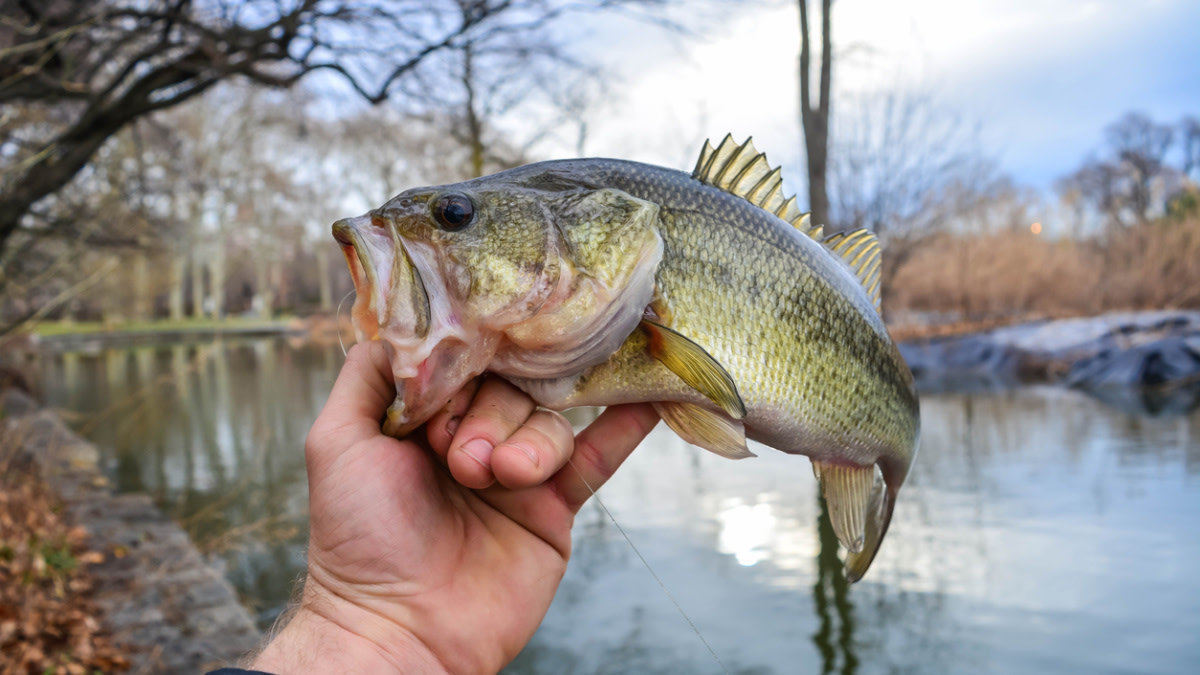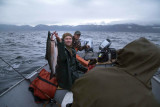
It’s that time of year when many people who don’t normally go fishing find themselves on a beach or boat and, often by no fault of their own, end up with a fish in their hands. These folks can to some degree be excused for improper handling. The rest of you should know better. It's important to observe best practices for fish handling both in order to keep our catch healthy and avoid harassment by other anglers on the water or on the web. Our community can be an argumentative lot.
First of all, if you’re going to kill the fish in question, it doesn’t really matter too much how you hoist it for a grip-’n’-grin—so long as you kill it quickly and take thoughtful care of the meat. Still, if you plan to disseminate those images to the big wide world, it wouldn’t hurt fishing culture to put in a little effort. That’s a life you’re taking. Plus, when you hold a fish the right way, it will look as big and beautiful on a screen as it did in person.
If you’re going to return that fish to the water, the way you handle it and the amount of time you keep it out of the water can make a big difference in its survival prospects. That's serious business with rivers as hot and low as they are right now. Just because a fish swims away from you doesn’t mean it won’t die or get sick later. Catch and release borders on wanton waste when it’s performed incorrectly.
Here are a few of the most common poor form moves you see floating, belly up, around on the social media swamp.
The Death Squeeze Fish are slippery, I get it. Novices often try to overcome this fact by holding as tightly as their fingers will allow. A useful analogue here is a bar of soap—the harder you squeeze, the more likely it’ll squirt free.

It takes practice and confidence to master controlling fish. A light but firm grasp around the peduncle or “wrist” just forward of the tail will allow you to manage the kicking, while the other hand behind the gill plates wrapping the pectoral fins seals the deal for many species. Fish will fight you harder the tighter you squeeze because you may actually be doing damage to their vital organs.
Signs you’re doing it wrong: bulged-out eyes and notable indentation of the body around your fingers.
The Giller Through the gills has been a common and helpful way to hold fish for as long as humans have been fishing. It should be associated primarily with harvest, but many anglers miss that nuance.

Fish breathe through a reverse osmotic process that extracts oxygen from the water directly into their bloodstream through their gills. If those delicate red tendrils get damaged, the process will reverse and blood begins flowing the other way, quickly leeching out into the water. Some fishes are more durable than others, but it’s still generally not good to touch the gills unless you actually want to bleed them out.
This move is complicated by the fact that there is actually a good, healthy, and effective way to hold some fish like northern pike and muskie by gripping their jaw outside of the membrane that covers their gills. That might look similar to the full-on gill grab, so it’s incumbent on every angler to know the difference.
Signs you’re doing it wrong: blood coming off the rakers is bad news. It’s best to just harvest a fish in that state. Any time your fingers are up under the gill plates you’re in dangerous territory.
The Jaw-Jacker Professional bass fishing on TV in the 1990s leaked a lot of bad behavior into the American fishing community. Holding a largemouth horizontally by only the lip may be among the more egregious habits we all learned back then. Tournament rules and practices have improved a lot since, yet this hold lingers.
There’s nothing inherently wrong with holding a bass or other smooth-toothed fish by the lip. You have more control there than anywhere else. But you should keep that fish mostly vertical if you’re holding with one hand, and support its rear end with the other hand if you want it to rest horizontally. Problems arise when anglers crank the fish over, flaring out the gills and setting the weight of the body on an angle against the head. Some studies have disputed the ill-health effects of jaw jacking, but I’ve personally caught bass that were permanently bent from this practice. It might not kill the fish, but that doesn’t mean you can’t do better.
Signs you’re doing it wrong: hard angle between the head and body, abnormally widened mouth.
The Dry Dock A devotion to only photographing fish while they’re partially submerged in the water has become prominent in some corners of the fly fishing community in recent years. It’s actually codified in law in some places for some species, like native steelhead in my home state of Washington. This “Keep ‘em Wet” movement is positive but not always practical. Say, if you’re in a boat, you must actually fight/handle that fish longer in order to get the angler and photographer out on the shore or shallows to pose the politically correct shot. It might be faster to just hoist that fish out of the net quickly, hit the shutter a couple times, and let the fish swim.

What’s important here is that the fish’s body stays moist at all times. The slime or mucus layer coating the scales on all fishes is important for fighting off parasites and infections. If it dries out, it’s gone. It’s also best to get your hands wet before grabbing a fish so you don’t wipe the slime off. Never hold a fish with gloves on if you want it to survive long-term. If you need to fiddle with the exposure or try another angle for your shot, put that fish back in the water to breathe while the camera holder resets.
Signs you’re doing it wrong: visibly dry scales; grass or gravel stuck to the flanks; fish laying on the dock, deck, or ground. You need to keep a fish controlled and moist, get your shot, then set it free.
The Eye-Gouge In our recent book, “The MeatEater Guide to Wilderness Skills and Survival,” I wrote that clutching a fish by the top of the head is one of the most effective ways to hand-grab and get it on the bank. The context was keeping yourself alive in a survival situation, so it's almost implied that this is a darn good way to kill a fish. But, if you don’t want that fish to die, keep your damn fingers out of its eyes and off its gill plates. The brain and other vital functions are imperiled with this hold. It's a favorite grip among pike and muskie anglers.

Signs you’re doing it wrong: hands on the top of head, near the eyes, or pinching the gill plates.
The Hot Trout Right now, most of the rivers within an hour of my house are closed to fishing after 2 p.m. or straight up closed entirely—regulations that are automatically triggered in Montana law when daytime water temperatures exceed 70 degrees. Several other states and Yellowstone National Park are implementing similar restrictions under drought conditions and heat waves in the West.
Most trout species become incredibly stressed when their environment gets this toasty. Catching and releasing them in water much above 70 degrees may be a death sentence. These problems are exacerbated every second they spend out of the water. I’m shifting my focus to walleye, pike, and bass until hunting season for that reason. If you want to stick with Salmonidae, bring any old thermometer with you to check the mercury in the water throughout the day. If you start to see that high-60s danger zone, it might be time for beers on the tailgate.
Signs you’re doing it wrong: don’t worry, a fly fisherman will tell you.
The Full Tarpon Probably the most contentious event in the online angling community this year came from a YouTuber who caught perhaps the largest hook-and-line tarpon ever recorded. The crew hauled the estimated 312-pound fish onto the boat and hoisted it between three men before sending it off. Many anglers questioned whether that fish off the coast of Colombia survived the ordeal.

There’s a lot more complexity to this story so I’ll save you some the bickering details. Suffice it to say that the trophy fishing community does not look kindly on hauling very large fish aboard unless it’s getting the priest and going in the hold. Big, powerful species like halibut, sailfish, marlin, tuna, goliath grouper, and certain sharks will often do significant damage to themselves out of water, not to mention any gear and human body parts nearby. Their organs are also designed to be suspended in the water, and the sheer weight of their bodies without that buoyancy can cause damage.
Signs you’re doing it wrong: Any fish over 70 pounds or so will not be easy to hold by yourself and should probably be kept in the water for images. A 30-pound ‘poon is one thing, but a 300-pounder is another story.
If these bad holds all sounded like pro-wrestling moves, yeah, that was intentional. The full Nelson is illegal in most forms of amateur wrestling and mixed martial arts because of the danger and damage it can cause to a human body. As anglers, we must treat our combatants with similar respect.
Yes, we stab them in the face, fight them to the net, and wrestle them into submission in front of a friend’s cellphone. But a measure of awareness and honor within that process can ensure that a released fish will survive, thrive, and be there for someone else to catch someday. These best practices also increase the appeal and defensibility of our sport to those viewing it from the outside.






Conversation